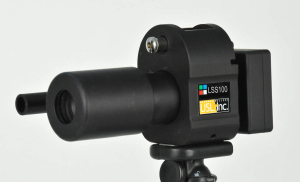
We are pleased to say that after years of design, programming and testing that it is indeed possible…and where it isn’t, it is possible to greatly assist the responsible tech to make a more refined judgement, more quickly. With a combination of facts – THD high and the indication that an array speaker is not on, or bulb flicker high and contrast low – the first tech visit can be a prepared visit instead of an expensive exporatory visit. Or even better, the emergency never happens because predictive information led to a scheduled maintenance visit.
Were the cables plugged in backwards? As we developed and showed the monitoring system to professional movie mixers, nearly every one spoke of the horror of sitting through a movie that they had been part of with the dialog coming from a side channel ! Not that the average customer’s complaint about loudness isn’t an issue, but really? dialog in a side channel?
 Swapped Inputs in Red, with Baseline and Results in degrees on the polar coordinate system, and the change from the baseline shown in degrees from the baseline’s reading.
Swapped Inputs in Red, with Baseline and Results in degrees on the polar coordinate system, and the change from the baseline shown in degrees from the baseline’s reading.
Thank you for your interest in this new approach to an engineer’s and artist’s goal. We hesitate to brag, but the ability to judge a speaker on a polar coordinate like the above also allows us to help pinpoint which LFE speaker cabinet isn’t responding because the amp is off or the speaker is missing. Only because we place our microphones in the sound field and not at the nodal dead zone of rear wall can we arm the tech with more information and better judgement more quickly.

Drawing showing placement of system pieces – BTW, the RS-232 connectors are replaced with RJ-45 in current models.
Sure. It is more difficult to place our 5 microphone system in the sound field of the room – it takes 15 or 20 minutes to put up and take down all that scaffolding – but the advantages are similar to having a person in the room. A person who can test each speaker at several frequencies in 5 minutes as well as point a 16-bit digital colorimeter at the screen, then calculate u’/v’ and luminance from 33 shades of grey (do you need 50?) and 4 intensities of each 6 primary and secondary color. …or design your own tests – do you need to test for 12.5 Hz? Do you need to sweep an array of speakers to determine if one or two aren’t really making sounds?
Enough about saving the tech support budget. How about proving something substantial to your customers. It might take some training-as-marketing, but you really think that your customers are worth it and you have the skills to speak to the math inclined. Years after the Digital Cinema adventure began, years after the complications of multiple light levels and bulbs for 3D movies, you can tell the responsible customer what they should expect and to know how well you are performing for them.

Easily convert the Guardian’s xml reports into HTML for In-Lobby displays.
We thank you for your interest and hope to have the opportunity to discuss how we can assist your Quality Assurance goals and purposes. There is power and room in the microphone saucer section for many more electronics. We look forward to your helping us define their parameters.
Digital Test Tools, LLC
Helping the Quality Active Deliver Their Customer’s Needs.







